|
1.
CENTRAL AND WEST AFRICA
Production disrupted by heavy rain
Industries in the region are experiencing significant
disruptions due to heavy rains, especially in Cameroon,
the Central African Republic (CAR) and northern Congo.
These adverse weather conditions have led to a serious
reduction in timber production with sawmill operations
being severely scaled back.
In Gabon and Congo, the rains have exacerbated the
deterioration of road infrastructure. In contrast, the
Republic of Congo has an advantage with most of its main
roads paved with tarmac from north to south facilitating
better movement of goods.
Transportation has become increasingly challenging,
especially on laterite roads that are still under repair. The
persistent rains are expected to continue for the next
couple of months further hindering production and
logistics in the region.
Coincidentally, the reduction in production comes when
demand in major markets is slow. There are reports of
large stocks of timber at Zhangjiagang Port as construction
activities in China have slowed down. Demand in niche
markets in China, such as for Azobe tabletops which were
once significant, are slowing down.
In Europe, demand for redwoods like Sapelli and Sipo
remains minimal. Sapelli prices are facing stiff
competition from lower-priced alternatives making it
difficult for exporters to maintain market share.
Exports to the Middle East continue but overall demand is
weak. Demand for Okoume in the Philippines appears to
have picked up.
Domestic markets in Cameroon, Gabon and the Republic
of Congo are currently purchasing Okoume of local
quality at around 160,000 FCFA per cubic metre
(approximately €243) ex-yard. However, high operational
costs are squeezing profit margins.
Gabaon NKOK Free Zone operators involved in the
peeling industry are purchasing peeler quality Okoume
logs at 65,000 FCFA delivered to the factory. Given the
high costs of felling, operations and transportation
producers are incurring losses.
Many Chinese mills are now focusing on processing local
species such as Okoume, Dabema, and Bilinga. The local
timber markets are predominantly controlled by traders
from Lebanon and West African countries like Mali.
There is currently little demand for redwoods like Sapelli,
Kossipo, Tiama and Sipo, except for specialised projects.
Exports of Sipo and Sapelli to Europe are minimal but
small shipments continue to the Middle East.
Government authorities in Cameroon and Gabon have
intensified checks on illegal logging activities.
Inspections have led to the identification of illegal
operations and some companies have been stopped from
operating pending payment of heavy fines.
This crackdown aims to regulate the industry and promote
sustainable practices. The Republic of Congo is noted as
being well organised in this regard with strict enforcement
and regulation of the timber industry.
Gabon
Harvesting and Production
Okoume timber maintains stable demand in the local
industry with preparations underway for the coming rainy
season affecting road conditions and prompting
stockpiling efforts.
Some factories in Nkok are operating at 50% capacity due
to a lack of customers and competition from Chinese
products made from logs sourced from Equatorial Guinea
and the Republic of Congo.
Operators in special economic zones, particularly the
Nkok zone in Gabon, are facing significant operational
challenges due to inconsistent electricity supply. Frequent
and unexpected power outages disrupt the functioning of
machinery, presses and kiln-drying chambers, leading to
production delays and financial losses.
Despite promises from the electricity provider, Société
d'Énergie et d'Eau du Gabon (SEEG), to resolve these
issues within a week, operators remain frustrated. The
unreliability of electricity supply hampers productivity and
affects the overall efficiency of timber processing
facilities.
Significant infrastructure projects
Studies are underway for a second railway track from the
Bélinga site to Mayumba Port near the Congo border,
involving the construction of a new deep-sea port. Chinese
funding is expected for these projects following
commitments made during the recent China-Africa
meeting in Beijing.
A South African/Australian company is studying a rail
track from Koulamoutou (southeast Gabon) to
Owendo/Libreville, though this remains in the planning
phase.
Cameroon
Challenging transportation
Heavy rains have been observed across Cameroon. The
main road to Sangmélima, a crucial route for timber
transport, is currently under repair by Chinese construction
teams. However, progress is being hampered by
continuous rains.
Railways are operating without major disruptions
providing an alternative means of transport where feasible.
In the northern regions of Cameroon severe flooding has
been reported, similar to neighboring Chad, resulting in
casualties and significant damage to housing and
infrastructure.
Sawmills have accumulated sufficient stock to maintain
operations until December when the dry season is
expected to return. Markets in the Middle East remain
stable, with consistent demand for timber products. The
Philippines also continues to show strong demand,
providing a valuable export destination for Cameroonian
timber.
Port activities in Douala and Kribi are functioning
normally. Douala handles both imports and exports of
general goods while Kribi focuses mainly on container
exports, including sawn timber from northern Congo.
Order levels are generally stable to low, varying by
species. Demand for redwoods and Ayous is decreasing.
Enquiry levels are stable with a lead time of one to two
months. Demand from China remains very low reflecting
broader market trends and economic conditions. The
Middle East market is said to be improving.
The government has implemented strict regulations to
ensure legal compliance in the timber industry.
Companies are now required to provide complete legal
documentation, including forestry and tax certificates for
each consignment.
Congo
Rains to continue until December
Harvesting activities in the Republic of Congo continue
but are affected by the rainy season. These disruptions are
expected to ease by December when the dry season
begins, typically lasting six months..
Trucking operations face some disturbances due to
ongoing road repairs. Port Access: Northern Congo
operations are exporting logs through the Port of Douala in
Cameroon although deliveries are falling. There are no
issues with container availability or stuffing operations,
facilitating smooth export processes.
Enquiries remain stable. The Philippines has resumed
purchases of Okoume sawn timber. There are functioning
niche markets in China but current prices are not meeting
suppliers' expectations.
Shift from Kevazingo to Ovangkol and Amazakoué
The Chinese timber industry appears to have shifted its
focus from Kevazingo to alternative species such as
Ovangkol and Amazakoué. This transition has led to
widespread harvesting of these species across the region
such that the market is oversupplied causing prices to
decline.
There are currently no suitable replacement species for
Azobé and Okan which are highly valued for specific
applications.
These hardwoods are specialised for large structural
components typically measuring 20 x 20 cm with lengths
of 5 to 8 metres. Sawmills favor these dimensions for
recovery sections due to their efficiency and yield.
Production of smaller, pointed squares in dimensions such
as 6 x 6 cm, 7 x 7 cm, and 4 x 4 cm is also limited.
Demand for these sizes is seasonal, declining during
autumn and winter as outdoor activities like gardening
decrease.
Some factories in Gabon and Cameroon have started
producing ‘damwand’ planks, planed timber sections
featuring tongue and groove profiles. This product
diversification caters to specific market niches and adds
value to the timber exported from the region.

Through the eyes of industry
The latest GTI report lists the challenges identified by the private
sector in the Republic of Congo and Gabon.
See: https://www.itto-
ggsc.org/static/upload/file/20240929/1727586546173092.pdf
2.
GHANA
Government to stop mining in forest reserves
The government has presented to Parliament an
instrument to revoke the Environmental Protection
(Mining in Forest Reserves) Regulations 2023 – LI 2462
which regulated mining in forest reserves..
This was one of organised labour demands when it
signaled its intention to strike over the negative impact of
‘galamsey’. The website of Asaaseradio in Accra has
published a copy of the government instrument.
In accordance with article 11(7) of the Ghana constitution
the Instrument comes into effect after 21 sitting days of
Parliament unless the votes of two-thirds of members of
parliament annul the instrument.
Following a meeting between organised labour and
government on 8 October the President, in a letter dated 9
October addressed to the leadership of organised labour,
outlined the various measures to address their concerns on
galamsey.
See: https://www.asaaseradio.com/government-revokes-mining-
in-forest-reserves-law-l-i-2462/
In related news, the Ghana National Association of Small-
Scale Miners (GNASSM) has announced a major
collaboration with the government to intensify efforts in
combating illegal mining and safeguarding the nation’s
vital natural resources.
This partnership aims to protect river bodies and forest
reserves and marks a new chapter in the fight against
environmental degradation caused by illegal mining.
During a press conference the GNASSM revealed that the
government has agreed to deploy specially trained
wardens and the navy to work alongside the association's
task force. These teams will patrol areas classified as "red
zones" which are particularly vulnerable to the destructive
effects of illegal mining to ensure that Ghana’s forests and
water bodies are protected.
See: https://www.graphic.com.gh/news/general-news/govt-
partners-with-small-scale-miners-to-protect-ghanas-rivers-and-
forest-reserves.html
and
https://3news.com/news/government-suspends-enforcement-of-l-
i-2462-on-mining-in-forest-reserves/
Livelihood support to forest fringe communities
The Ministry of Lands and Natural Resources, on behalf
of the Forestry Commission, has signed a Letter of Intent
with the Government of the United Arab Emirates (UAE)
for a grant of US$30 million. The grant will provide
additional and alternative livelihood support to forest
fringe communities as an incentive for them to engage in
enhanced forest protection, forest restoration and
reforestation.
This forms part of efforts by the Government of Ghana to
achieve the biodiversity and climate objectives under the
Resilient Ghana Package launched at COP28 in Dubai last
year.
The Minister for Lands and Natural Resources, Samuel
Abu Jinapor, who signed on behalf of Ghana, reiterated
the government’s commitment to developing strategies to
restore habitats, protect endangered species and promote
resilient ecosystems.
In 2022, at COP27 in Sharm El Sheikh, Egypt, the Ghana
President and the then UK Prime Minister, Rishi Sunak,
launched the Forest and Climate Leaders’ Partnership
(FCLP) as a new political forum that brings governments
and partners to work together to implement solutions that
reduce forest loss, increase restoration and support
sustainable development.
Subsequently at the COP28 in Dubai, Ghana launched her
Resilient Ghana Package for nature, climate and people
under the FCLP.
The Resilient Ghana package includes an integrated
system-wide suite of interventions to help halt and reverse
forest loss while delivering sustainable development and
promoting inclusive rural transformation.
See: https://fcghana.org/ghana-secures-30m-uae-grant-for-
forest-conservation/
Primary products - largest share of exports
According to the Timber Industry Development Division
(TIDD) of the Forestry Commission (FC), revenue from
the export of primary products accounted for more than
57% (Eur41.13 million) of the total wood export trade for
the year to July (Eur71.27 million). This was followed by
secondary wood products (SWP) and tertiary wood
products with 38% and 5% respectively.
Compared to the same period in 2023; primary, secondary
and tertiary wood products export receipts accounted for
56%, 38% and 6% as shown in table below;
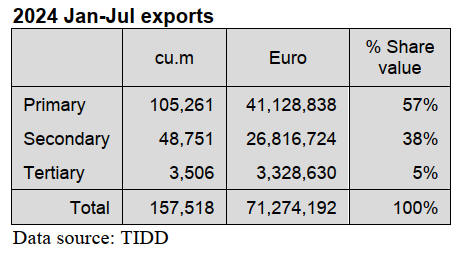
Primary products comprised billets, air-dried boules,
kindling, air-dried sawnwood, kiln-dried sawnwood for
the regional market, rollboard and teak logs. These
products earned Eur41.128,838 from a volume of 105,261
cu.m of the total export of wood products between January
and July 2024.
The figures indicated a decrease of 10% in volume and a
decrease of 9% in value respectively when compared to
the timber export figures for the same period in 2023.
Secondary wood products, which comprised kiln-dried
boules, briquettes, kiln-dried sawnwood, plywood, rotary
veneer and sliced veneer, generated Eur26,816,724 from a
volume of 48,751 cu.m for the same period. Compared to
the figures for the same period last year there was a
decrease of 14% in volume and a decrease of 15% in
value.
The report also showed that tertiary wood products,
mainly mouldings, contributed Eur3,328,630 from the
volume of 3,506 cu.m to the total wood products export
from January - July 2024. The current year’s figures
indicated a decrease of 34% in volume and a decrease of
28% in value against those for January - July 2023.
Utility tariffs rise
The Public Utilities Regulatory Commission (PURC) has
announced an upward adjustment to utility tariffs with
electricity prices to rise by 3.02% and water tariffs by
1.86%.
The changes come as part of the regulator’s routine
quarterly review designed to reflect shifts in key economic
indicators, including the US$/Cedi exchange rate, inflation
and natural gas costs.
See: https://www.graphic.com.gh/news/general-news/purc-
announces-3-02-hike-in-electricity-tariffs-1-06-in-water-tariffs-
effective-october-1.html
Rate cut for commercial banks
The Monetary Policy Committee (MPC) of the Bank of
Ghana (BoG) has cut the rate at which it lends to
commercial banks by 200 basis points to 27% from 29%.
Dr. Ernest Addison, Governor of the BoG and Chairman
of the committee, noted that the action was influenced by a
favorable economic outlook.
He further explained that since the first quarter of the year
headline inflation has declined for 5 consecutive months.
He added that core inflation has also declined.
The Association of Ghana Industries (AGI), which has
been engaging government on promoting a conducive
business environment for competitive production of goods
for both local and the international markets, has not yet
commented on these announcements.
See: https://www.myjoyonline.com/monetary-policy-committee-
cuts-lending-rate-significantly-to-27-percent/
Ghana’s intra-African exports
In 2023 Ghana ranked the fourth African country with the
biggest intra-African exports on the continent, with
exports valued at US$6.02 billion of the total intra-African
exports.
South Africa leads with total intra-African exports valued
at US$29.61bil. followed by Cote d’Ivoire and Egypt with
intra-African trade exports value of US$11.38bil. and
US$6.61bil. respectively.
See: https://media.afreximbank.com/afrexim/African-Trade-
Report_2024.pdf

Through the eyes of industry
The latest GTI report lists the challenges identified by the private
sector in Ghana.
See: https://www.itto-
ggsc.org/static/upload/file/20240929/1727586546173092.pdf
3. MALAYSIA
EUDR compliant plywood
According to the Sabah Forestry Department the State has
exported a 45 cubic metre shipment of what has been
called ‘EUDR-compliant’ plywood to Poland. The raw
material was said to be responsibly sourced from Sapulut
Forest Development, a Sustainable Forest Management
License Agreement licensee under the Sabah State
Government’s jurisdiction and the oversight of the Sabah
Forestry Department.
Frederick Kugan, Chief Conservator of Forests for the
Sabah Forestry Department said “through compliance with
the EUDR we are not only enhancing the credibility of
Sabah’s timber products but also contributing to global
efforts in combating deforestation and climate change”.
“Our success in delivering the first EUDR-compliant
shipment to Europe amid ongoing debates over the
regulation is a reflection of our dedication to preserving
our natural resources and advancing Sabah’s forestry
sector”, he said.
To demonstrate its commitment to sustainability Sabah has
developed the Sabah Timber Legality Assurance System
(Sabah TLAS), a mandatory third-party audited system
that ensures legality and transparency across the entire
timber supply chain.
See:
http://theborneopost.pressreader.com/article/281513641586292
Borneo Forestry Cooperative
The Borneo Forestry Cooperative (BFC) was founded in
2009 by Sabah Softwoods and Asian Forestry Company
(Sabah) in collaboration with Boden and Associates Ltd.
The BFC serves as a collaborative platform bringing
together industry leaders to drive innovation in plantation
management.
From an informal cooperative the BFC has evolved into a
Malaysian registered company, BFC Research and
Development Sdn Bhd. During a Management Open Day
the work at Sapulut Forest Development (SFD) was
highlighted.
SFD has planted over two million fast-growing trees,
including Laran and Red Mahogany species. At the open
day managers from SFD said the Malaysia’s timber
industry needs innovative approaches to reduce reliance on
natural forests.
See: https://www.dailyexpress.com.my/news/242786/two-
million-fast-growing-trees-planted-in-sapulut/
World Bank raises growth forecast
The World Bank has upgraded Malaysia's economic
growth forecast to 4.9% in 2024 from its initial 4.3%
forecast set in April according to Apurva Sanghi, its lead
economist for Malaysia.
He said both domestic and external factors back the
upgraded growth forecast as the global economy is doing
much better than expected six months ago.
On the domestic front, he said the positive economic
momentum, political stability and an increasingly
conducive policy environment that boosts and mobilises
more investments have contributed to the upgraded growth
projection.
See: https://www.thestar.com.my/business/business-
news/2024/10/08/world-bank-upgrades-malaysia039s-growth-
forecast-to-49-in-2024
Kenaf - appealing to smallholders
The kenaf industry needs more government support to
accelerate its growth and attract more smallholders to
engage in its cultivation which could significantly
contribute to the national economy, according to Deputy
Plantation and Commodities Minister Chan Foong Hin.
He noted that although kenaf is relatively new compared
to other commodities, its unique qualities such as the short
three-month cultivation cycle make it appealing to
smallholders.
Chan emphasised that government assistance is crucial as
the Ministry aims to establish an ecosystem where every
industry would have its own upstream, midstream and
downstream sectors.
In 2023, the market value of kenaf products reached
RM8.88 million, an increase of almost 60% compared to
2022. As of the second quarter of 2024 the market value of
kenaf products has reached RM6.28 million, marking a
74% year on year increase.
See:
http://theborneopost.pressreader.com/article/282256670889138
Through the eyes of industry
The latest GTI report lists the challenges identified by the private
sector in Malaysia.
See: https://www.itto-
ggsc.org/static/upload/file/20240929/1727586546173092.pdf
4.
INDONESIA


Processed wood (prices per cu.m)
Processed wood products which are leveled on all four
sides so that the surface becomes even and smooth with
the provisions of a cross-sectional area of 1,000 sq.mm to
4,000 sq.mm (ex 4407.11.00 to ex 4407.99.90)
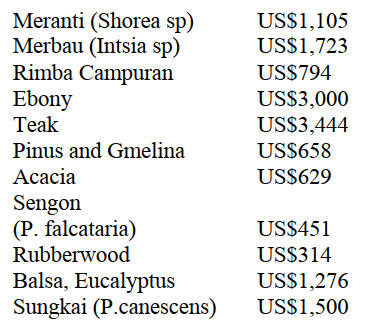
Processed wood products which are leveled on all four
sides so that the surface becomes even and smooth of
Merbau wood with the provisions of a cross-sectional area
of 4,000 sq.mm to 10,000 sq.mm (ex 4407.11.00 to ex
4407.99.90); US$1,500/cu.m
See :https://jdih.kemendag.go.id/peraturan/keputusan-menteri-
perdagangan-nomor-1329-tahun-2024-tentang-harga-patokan-
ekspor-dan-harga-referensi-atas-prdouk-pertanian-dan-
kehutanan-yang-dikenakan-bea-keluar
Boosting exports of sustainable forest products
The Ministry of Environment and Forestry is continuing
its efforts to increase the export value of responsibly and
sustainably produced forest products.
Ristianto Pribadi, Director of Forest Product Processing
and Marketing Development in the ministry stated that
efforts to boost export value will be accompanied by
measures to enhance product value in the domestic market,
thereby promoting the downstream processing of forest
products.
"The success of sustainable forest management depends
on all parties involved in the wood product supply chains
until they reach consumers. To this end, it is crucial to
improve traceability, efficiency and the preservation of
raw material sources," he said.
He explained that modernising equipment in the forest and
wood product processing industry can increase the value
of the raw materials used and reduce production waste.
He urged the forestry sector to innovate in addressing
global challenges, particularly those related to greenhouse
gas emissions.
In related news, the Director of Forest Products
and
Plantation Industry in the Ministry of Industry
(Kemenperin), Setia Diarta, revealed that wood processing
mills in Indonesia use mostly imported machinery which
could create opportunities for local companies to
manufacture machinery possibly through joint ventures
with overseas manufacturers. She anticipates that through
collaboration between Indonesia and China there can be
technology transfer.
See: See: https://www.antaranews.com/berita/4357103/klhk-
pameran-manufaktur-furnitur-dukung-modernisasi-hasil-hutan
and
https://www.antaranews.com/berita/4357571/kemenperin-akui-
mesin-pengelolaan-kayu-masih-gunakan-mesin-impor
Forestry sector under performing
Sudarsono Soedomo, Professor of forestry at the Bogor
Agricultural Institute (IPB) pointed out that there has been
limited investment in the forestry sector which hinders
future prospects. According to him, out of the total
domestic Investment between 2020-2022, which amounted
to IDR3,256 trillion, the forestry sector only managed to
attract investments of IDR28 trillion. Out of the total
Foreign Direct Investment of IDR50,267 trillion in 2023
only IDR96 trillion was invested in the forestry sector.
"The small investment is inversely proportional to the vast
forestry area. Of the total land area in Indonesia, 2/3 is
forest area," said Sudarsono Soedomo in a statement. He
added; the natural forest industry is shrinking while the
development of plantation forests is progressing very
slowly. Forests account for 2/3 of the land but the forestry
sector contributes less than 1% to the GDP".
See: https://www.liputan6.com/bisnis/read/5714923/investasi-
sektor-kehutanan-melempem-dalam-2-tahun-pengamat-fakir-
investasi?page=3
and
https://kumparan.com/kumparanbisnis/guru-besar-ipb-soroti-
sektor-kehutanan-ri-masih-minim-investasi-23cj79tNSIZ/full
Responses to delay in EUDR implementation
The Indonesian government has called for the revision of
the European Union Deforestation Regulation (EUDR).
Airlangga Hartarto, the Coordinating Minister for
Economic Affairs, said that Indonesia has a number of
concerns regarding the regulation including the
requirement for Indonesia to provide detailed geo-location.
In addition, Indonesia has expressed its concern to the EU
on the so-called country rating approach.
In related news, Hartarto invited all ASEAN member
countries to unite in responding to global sustainability
policies which tend to be discriminatory. Airlangga
conveyed this at the 24th ASEAN Economic Community
Council – AECC Ministerial Meeting.
In the midst of increasing global attention to the
impact of
the implementation of the EU Deforestation Regulation
(EUDR), which has the potential to disrupt manufacturing
production and hamper trade in wood, plant and
plantation-based products, Indonesia continues to strive to
build networks and gather support.
See: See: https://en.antaranews.com/news/328251/indonesia-
pushes-for-revision-of-eu-deforestation-regulation
and
https://asiatoday.id/read/indonesia-galvanizes-asean-collective-
against-eudr-implementation
The Association of Indonesia Forest Concession Holders
(APHI) sees the postponement of the European Union
Deforestation Regulation (EUDR) until 2026 as an
opportunity to prepare its members for the Regulation.
APHI has urged the government to advocate for SVLK as
the primary instrument to address the EUDR and bolster
its position in the European Union market. "The
government must persist in advocating for SVLK as a
recognised tool for the European Unionmarkets in the
context of the EUDR," he added.
APHI has urged member companies to engage in
extensive consultations with the government to ensure
compliance with all EUDR requirements. This
consultation is crucial for the Indonesian forestry industry
to establish operational standards that align with the
regulations set to take effect in 2026.
See: https://industri.kontan.co.id/news/strategi-aphi-menghadapi-
penundaan-kebijakan-eudr
Abdul Sobur, Chairman of the Indonesian Furniture and
Craft Industry Association (HIMKI) also said the
postponement of the implementation of the EUDR
provides an opportunity for the furniture and craft industry
in Indonesia to prepare and that the Indonesian furniture
industry is making significant efforts to align its supply
chain with the traceability and sustainability standards
outlined in the EUDR.
"However, small and medium enterprises (SMEs) face the
biggest challenge as they still struggle to access
traceability technology and encounter high verification
costs," Abdul stated.
See: https://industri.kontan.co.id/news/menilik-kesiapan-industri-
mebel-dan-kerajinan-hadapi-kebijakan-eudr
EUDR stalling conclusion of IEU-CEPA
The Indonesia-European Union Comprehensive Economic
Partnership Agreement (IEU-CEPA) continues to face
significant hurdles with the EUDR emerging as a major
stumbling block according to Djatmiko Bris Witjaksono,
Director General of International Trade Negotiations at the
Ministry of Trade.
While progress has been made on issues such as tariff
reduction, trade facilitation, investment and transparency,
policy-related hurdles—especially those stemming from
the EUDR—have significantly delayed the negotiation
process. Despite 19 rounds of talks over nine years, the
previously set September 2024 target for IEU-CEPA
completion passed without agreement, Witjaksono said.
See: https://jakartaglobe.id/business/ongoing-eu-demands-lead-
to-ieucepa-delayed-again-says-trade-minister
In related news, Shinta Kamdani, the chairwoman of the
Indonesian Employers Association (Apindo) has said
Indonesia will likely lose billions in exports if it cannot
close the overdue deal with the European Union. She
added that the lack of the trade pact could affect the
attractiveness of Indonesian goods in the European market
and the US$1.6 billion export trade with the EU is at risk.
The trade loss would be equivalent to around 12% of
Indonesia’s total exports to the EU. In the long run, we
might even lose our trade surplus with the EU,” Shinta
told reporters in Jakarta on Friday.
See: https://jakartaglobe.id/business/indonesia-can-lose-16-
billion-without-eu-trade-pact

Social forestry raises income for 1.4 mlllion families
The government's social forestry programmes have
increased the income of families living near forests
according to Minister of Environment and Forestry Siti
Nurbaya. She stated that the social forestry programmes
cover 8 million hectares with around 1.4 million families
having access to them. These programmes have increased
family monthly incomes to around Rp2.3 million
(approximately US$152).
The Norwegian Ambassador to Indonesia, Rut Kruger
Giverin, expressed appreciation for the Indonesian
government's efforts to reduce the impact of deforestation
and environmental pollution through various initiatives,
including social forestry.
She emphasised the importance of developing the social
forestry programme in Indonesia,as it is considered to
have gained attention at the global level.
See:https://wartaekonomi.co.id/read545675/klhk-klaim-
perhutanan-sosial-tingkatkan-pendapatan-masyarakat-sekitar
5.
MYANMAR
Currency appreciation
In foreign currency markets the US dollar was trading at
4,500 kyats per dollar in October. In response to a growing
foreign exchange crisis the State Administration Council
(SAC) mandated that exporters exchange their foreign
exchange earnings at a rate of 2,100 kyats per US dollar.
The amount that had to be exchanged was first 35% later
adjusted 25% of total export earnings.
The Central Bank of Myanmar is actively managing the
dollar' exchange rate however, due to ongoing instability
in the country, analysts believe the strength of the kyat is
unlikely to improve in the long term as the export sector
has suffered leading to a decline in foreign earnings.
Last year the dollar was exchanged at between 3,300 and
3,400 kyats, stabilising around 3,500 at the end of the
year. However, at the beginning of 2024 the dollar began
to strengthen reaching 3,800 kyats. This upward trend
continued culminating in a price of 7,000 kyats by August.
See: https://burmese.dvb.no/post/672194
More pressure on Myanmar migrant workers
Myanmar has implemented new restrictions on migrant
workers, exacerbating an already difficult situation for
those seeking work overseas. Many workers attempted to
travel with a tourist visa but were denied departure at
Yangon International Airport. The Authorities are now
enforcing stringent checks on outbound travelers requiring
them to provide return tickets, hotel bookings and proof of
sufficient funds targeting those suspected of intending to
work abroad.
This crackdown comes as the government seeks to collect
taxes from migrant workers and stem the tide of
emigration amidst ongoing conflict, economic collapse
and a military conscription drive. Between January 2022
and July 2023 it has been estimated some 2 million people
have left Myanmar with many more likely crossing
borders illegally.
In related news, a Thai member of Parliament said
Thailand needs to reform its policies regarding the influx
of refugees from Myanmar. He advocates registering the
estimated 6 million Myanmar migrants in Thailand to
grant them legal status, access to education and the ability
to work. This recognition could help improve living
conditions for refugees.
See: https://www.frontiermyanmar.net/en/blocking-the-exits-
myanmar-junta-turns-the-screws-on-migrant-workers/
New policy approach by ASEAN countries
Prime Minister, Senior General Min Aung Hlaing,
expressed the country's desire to reset relations with all
ASEAN Member States as they prepare for the 18th
ASEAN Navy Chiefs’ Meeting. He met ASEAN Navy
Chiefs in Myanmar and reiterated Myanmar's commitment
to upholding the ASEAN spirit and maintaining
constructive ties with member nations.
In related news, Malaysia's Foreign Minister Datuk Seri
Mohamad Hasan has been reported as saying the crisis in
Myanmar has become a pressing issue for ASEAN with
millions displaced and ongoing human rights concerns and
stressed the need for implementation of the Five-Point
Consensus Plan.
Thailand’s foreign ministry spokesperson, Nikorndej
Balankura, announced plans for an "informal consultation"
among ASEAN members in December to seek solutions,
emphasising a desire for political resolution while
coordinating efforts within the ASEAN framework.
See - https://elevenmyanmar.com/news/senior-general-min-aung-
hlaing-emphasizes-commitment-to-strengthening-relations-with-
asean
and
https://www.msn.com/en-us/news/world/asean-holds-summit-in-
laos-as-thailand-floats-new-plan-for-myanmar-crisis/ar-
AA1rVPXZ?ocid=BingNewsVerp
6.
INDIA
Wood panel price index
tilts higher
The annual rate of inflation based on the India Wholesale
Price Index (WPI) was 1.31% for August 2024. The rate
of inflation in August was primarily due to increase in
prices of food articles, processed food products, other
manufacturing, manufacture of textiles and manufacture of
machinery & equipment etc.
Out of the 22 NIC two-digit groups for manufactured
products, 12 groups saw an increase in prices, 7 a decrease
and 3 groups saw no change in prices. Groups for which
month on month price increases were reported were
manufacture of food products, fabricated metal products
except machinery and equipment, motor vehicles, trailers
& semi-trailers, machinery and equipment, paper and
paper products. The indices for wood panels and
sawnwood rose in August.
Some of the groups for which declines were reported were
manufacture of basic metals, other manufacturing, other
non-metallic mineral products, chemicals and chemical
products and textiles. In August the price index for
veneers declined.
See: https://eaindustry.nic.in/pdf_files/cmonthly.pdf
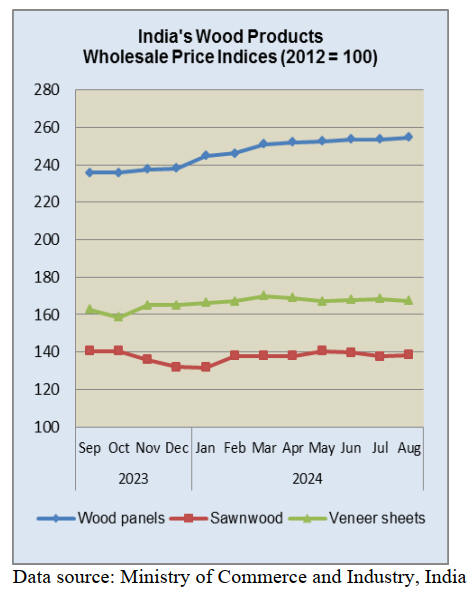
India needs 3 mil. ha. of forest plantations
Several recent reports point to a looming wood shortage in
many countries and India is one. At the recently concluded
Matecia Exhibition the supply of raw material for the
woodbased panel sector was discussed. It was suggested
that for the Indian wood panel industry to be raw material
self-sufficient over 3 million ha. of plantations would be
needed.
The September issue of Ply Reporter provides a
commentary on the issue and highlights presenations by
panel manufacturers and analystys including Rajesh Jha
Regional Manager ITC Limited, Ajay Thakur, Scientist E,
Forest Research Institute (FRI) and J.K. Jain Vice-
President Greenply Industries.
In related news, Century Plyboards has announced it plans
on expanding plywood production capacity by around
30% in the next 12-15 months. The Hindu Businessline
says the company currently has an annual production
capacity of 339,600 cubic metres adding Century
Plyboards has around an 8% of the ‘organised‘ market
segment.
The Hindu Businessline quotes an executive from the
company as saying “Two-three years ago, the bulk of the
raw materials used to come from domestic agro-forests but
demand has outstripped supply“.
See; https://www.thehindubusinessline.com/companies/century-
plyboards-to-expand-plywood-production-capacity-by-
30/article68630958.ece
and
https://www.facebook.com/plyreporter/posts/pfbid02bcaEzwNxE
p4TjKgRmNrHA8rafs6azXU8h3aiDWuweXr47m8fbMprsW9Fg
PMqgwbl?locale=en_GB
Launch of US$1 bil. affordable housing fund
Nikkei Asia has reported Indian investment company
HDFC Capital, a subsidiary of the country's largest private
bank and a World Bank Group unit will launch a US$1
billion fund in early 2025 to promote the building of
affordable housing for the middle classes.The World Bank
Group's International Finance Corporation (IFC) will offer
up to US$150 million to the fund which will focus on
investing in green loans and other instruments issued by
Indian developers of green residential housing.
See: https://asia.nikkei.com/Business/Finance/India-s-
HDFC-Capital-to-launch-1bn-affordable-housing-
fund?utm_campaign=GL_asia_daily&utm_medium=email
&utm_source=NA_newsletter&utm_content=article_link
&del_type=1&pub_date=20241003193000&seq_num=21
&si=fe0afe7c-532b-443e-bd57-30a8db100322
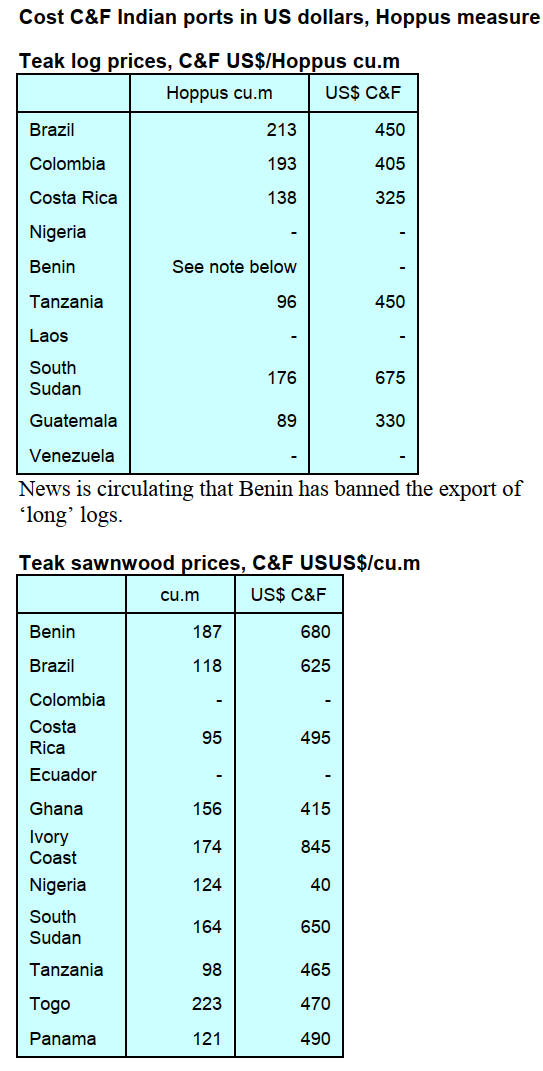

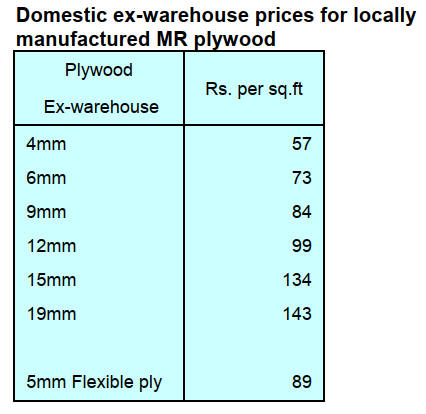
7.
VIETNAM
Wood and wood product (W&WP) trade
highlights
Statistics from Vietnam’s General Department of
Customs reveals that W&WP exports to the US in
September 2024 reached US$712 million, down 17%
compared to August 2024 but up 15% compared to
September 2023. In the first 9 months of 2024 Vietnam’s
W&WP exports to the US totalled US$6.5 billion, up 25%
over the same period in 2023.
In September 2024 bedroom furniture exports
fetched US$162 million, up 23% compared to September
2023. In the first 9 months of 2024 exports of bedroom
furniture contributed US$1.48 billion to export earnings,
up 28% over the same period in 2023.
Vietnam's W&WP imports in September 2024
amounted to US$265 million, down 2% compared to
August 2024 but up 40% compared to September 2023. In
the first 9 months of 2024 W&WP imports totalled
approximately US$2.06 billion, up 28% over the same
period in 2023.
Vietnam’s NTFP exports in September 2024
decreased for the 3rd consecutive month reaching US$60
million, down 10% compared to August 2024 but still up
13% over the same period in 2023. In the first 9 months of
2024 NTFP exports contributed US$605 million, up 12%
over the same period in 2023.
Wood and NTFP exports - double digit growth
According to Department of Forestry (Ministry of
Agriculture and Rural Development) with an average
export value of wood and non-timber forest products
reaching nearly US$1.4 billion/month exports of wood and
forestry products in the first 9 months of 2024 are
estimated at US$12.15 billion, up 17% over the same
period in 2023.
Out of which, wood products reached US$7.84 billion, up
21% over the same period in 2023, raw wood US$3.533
billion, up 13% over the same period in 2023 and non-
timber forest products US$777 million, up 4% over the
same period in 2023.
On other hand, imports of wood and wood products in the
first 9 months of the year are estimated at US$2 billion, up
25 over the same period in 2023. The trade surplus in the
first 9 months of 2024 is estimated at US$10.1 billion. It is
expected that export earnings from wood and forest
products in 2024 will meet set target.
In the first 9 months of 2024, except for S. Korea and
Japan, the other major consumer markets maintained quite
strong growth. For example the United States reached
US$5.9 billion, accounting for 54%, up 25% over the
same period in 2023 followed by China with US$1.3
billion and Europe with US$630 million each increasing
by over 20% compared to the same period in 2023.
Major challenges in international markets
According to Trieu Van Luc, Deputy Director of
Department of Forestry, currently some of Vietnam's main
wood product export markets (EU, US, Japan, South
Korea) still face economic difficulties; product protection
policies, strict implementation of regulations on illegal
wood exploitation, reduction of greenhouse gas emissions,
regulations on deforestation and forest degradation of
European Union (EUDR), anti-dumping and anti-subsidy
investigations of the US and South Korea.
The world situation continues to face geopolitical risks,
complex and unpredictable economic fluctuations,
increasing risk and uncertainty factors. In addition the
impact of high sea freight rates leading to an increase in
prices of imported raw wood (some imported wood
increased by 40% compared to 2023), is causing
production costs to rise while importers require a
reduction in prices.
The refund of value-added tax (VAT) for enterprises
producing wood chips and plywood products still faces
many difficulties because verification procedures for
forest owners takes a lot of time.
In addition, there are difficulties in damage caused by
storm No.3. This storm caused severe damage to property,
crops, livestock and socio-economic infrastructure, in
which forestry production sector also suffered great
damage. An area of nearly 170,000 hectares of planted
production forests was damaged which will significantly
reduce the source of raw materials for the wood processing
industry. Many wood and forestry production and export
establishments in northern mountainous provinces were
damaged and need to be repaired.
In order to achieve the export target for wood and forest
products in 2024 of US$15.2 billion, of which wood and
timber products are over US$14.2 billion an increase of
about 6% in exports is required compared to 2023.
Trieu Van Luc said that entire forestry sector is currently
focusing on overcoming consequences caused by storm
No.3 promptly supporting units and enterprises in forestry
production, wood processing and export of damaged forest
products to quickly stabilise production.
The Department will deploy solutions according to the
direction of the Prime Minister in Official Dispatch
No.470 dated May 26, 2023 on continuing to resolutely
and effectively implement tasks to remove difficulties for
production and business of enterprises and people.
See:
https://asemconnectvietnam.gov.vn/default.aspx?ZID1=8&ID8=
139310&ID1=2
Need to establish forest carbon standards
On the morning of 3 October the Department of Forestry,
in collaboration with the Association of Agricultural and
Rural Development Economics, organised a Workshop
“Forest Carbon - Potential to Create New Financial
Sources for Forest Protection and Development” with
sponsorship from Forest Trends and UK PACT.
The workshop attracted the participation of about 150
direct delegates and nearly 250 online connections
nationwide.
In his opening speech, Associate Professor Dr. Tran
Quang Bao, Director of the Department of Forestry, said
that forestry is currently the only sector with the potential
for negative net emissions thanks to the process of forest
protection and development and the support of
international partners. However, the forest carbon market
in Vietnam is still in its early stages, facing many
difficulties and challenges.
Recently, Vietnam received US$51.5 million from the
World Bank for successfully capturing 10.3 million tonnes
of CO2 in 6 provinces in the North Central region.
Currently the Ministry of Agriculture and Rural
Development is completing the dossier to submit to the
Prime Minister for consideration and negotiation and
signing the Emission Reduction Purchase Agreement for
11 provinces in the Central Highlands and South Central
region with the Forestry Finance Enhancement
Organisation (Emergent).
"The forest carbon market has the potential to generate
large revenues for forestry helping to support forest
protection, create jobs, increase income for local people
and at he same time protecting and improving
environmental quality said Bao, He admitted, however,
that financial resources for forestry activities are still
insufficient meeting only a small part of actual needs.
The Forestry Department also identified 7 essential tasks
to promote market development and commercialisation of
forest carbon credits:
(1) Review and update the nationally determined
contribution in the forestry sector;
(2) Study the potential and allocate quotas for emission
reduction and carbon sequestration from forests to
localities;
(3) Perfect the policy and institutional framework on the
transfer and financial management of revenue from forest
carbon credits;
(4) Develop Vietnam forest carbon standards,
methodology for calculating emission reduction results
and a system for measuring, reporting and appraising the
amount of emission reduction and increased carbon
sequestration of forests; guide the development and pilot
implementation of several potential projects;
(5) Disseminate and enhance capacity for stakeholders on
forest carbon;
(6) Continue to implement the Emission Reduction
Payment Agreement with the World Bank; advising on
negotiations, signing and implementing the Emission
Reduction Trading Agreement for the Central Highlands
and South Central regions with the Emergent
Organization;
(7) Strengthening cooperation, mobilizing international
resources and the private sector.
For localities the Director of the Forestry Department
proposed proactively mobilising and integrating legal
resources to reduce emissions and increase forestry
absorption in the province while calling for the active
participation of relevant parties to promote the sustainable
development of the forest carbon market.
"The cooperation and commitment of all relevant parties
will be the decisive factor for the success of the forestry
sector in the new context," Bao said.
See: https://vietnamagriculture.nongnghiep.vn/urgently-build-
forest-carbon-standards-in-vietnam-d402299.html
8. BRAIL
Promoting good practices in wood sample
collection
The First Meeting of Tree Identifiers, held in the
municipality of Alta Floresta in the state of Mato Grosso,
in the Amazon region brought together 40 professionals to
strengthen forest management and promote good practices
in botanical and wood sample collection.
The event was organised by the Center for the Wood
Producers and Exporters Industries of the State of Mato
Grosso (CIPEM) and the State Department of
Environment (SEMA), in partnership with local
universities.
SEMA stressed the importance of ensuring the
sustainability of biodiversity and accuracy of forest
inventories, guaranteeing security and efficiency in the
licensing process as well as preserving and conserving the
environment.
The Federal Rural University of the Amazon (UFRA)
emphasised the collective benefits for the timber sector
and society as it brings together research and educational
institutions for those involved in licensing process,
accreditation and inspection agencies such as SEMA and
entrepreneurs in the timber industry. The National Institute
of Amazonian Research (INPA) emphasised that the
correct identification of timber species is essential for
sustainable forest production.
The meeting was considered a milestone for forest
activities and botanical research in the region, promoting
interaction among experts and strengthening forest
management practices.
See: https://cipem.org.br/noticias/identificacao-de-arvores-
comerciais-da-amazonia-e-fortalecida-em-evento-inedito-em-
mato-grosso
Paraná wooden house programme
The government of the State of Paraná in southern Brazil
signed a protocol to develop a programme for building
sustainable wooden houses for families in vulnerable
situations in rural areas including low-income families,
indigenous communities and quilombola communities.
The initiative, developed in partnership with Águia
Florestal and the Paraná Association of Forest-Based
Companies (APRE), will use Cross Laminated Timber
(CLT) technology.
The project aims to promote social development combined
with sustainability by utilising state-managed planted
forests to reduce carbon emissions and foster the bio-
economy. The houses will be built with wood sourced
from reforestation areas managed by the Department of
Agriculture which were previously underutilised.
The State of Paraná has 33,000 hectares of planted forests
and accounts for 55% of Brazil's pine wood production,
leading the country's exports of plywood, wood-based
panels and wooden frames. The programme seeks, not
only to reduce the housing deficit in rural areas, but also to
highlight the importance of sustainable forestry practices
in combating climate change and promoting local
economic development.
See: https://apreflorestas.com.br/noticias/parana-lanca-programa-
para-construir-casas-sustentaveis-com-madeira-e-atender-
pessoas-em-vulnerabilidade/
Debate on timber export routes and logistics solutions
in Mato Grosso
The State of Mato Grosso is the second largest producer of
products from native timber species in Brazil with more
than half of its municipalities engaging in forest-related
activities for their socio-economic development.
In 2023, 75 of the 142 municipalities in the State produced
2.1 million cubic metres of roundwood, valued at R$498.1
million according to the Brazilian Institute of Geography
and Statistics (IBGE).
Additionally, exports of local forest products generated
US$47.1 million between January and August according
to the Ministry of Development, Industry, Commerce and
Services (MDIC).
A recent forest sector unions (Associations) meeting
discussed options to improve international timber trade
including the analysis of new port routes based on a
technical and economic feasibility study. Timber
industries in the state of Mato Grosso face export
challenges due to delays in containers clearance caused by
the lack of IBAMA (Brazilian Institute of Environment
and Renewable Natural Resources) technicians at
maritime ports.
CPEM asserts these port inefficiency continues to affect
timber exporting industries even after the end of the
national strike by IBAMA employees which lasted 40
days this year, resulting in losses for exporters due to the
backlog of halted shipments.
CIPEM also criticised the charging of port fees during the
strike period. FIEMT (Federation of Industries of Mato
Grosso) representatives said it is essential to diversify
transportation logistics to improve and speed-up the flow
of products from the State of Mato Grosso as well as to
expand export routes.
The study presented by FIEMT suggested using the Dry
Port of Cuiabá to shorten the time it takes to obtain
approval from regulatory agencies and the time it takes to
ship goods, as well as utilising rail transport to the Port of
Santos as a logistical solutions.
The forest sector stands out in terms of exports from
municipalities in Mato Grosso State. In the Juína
municipality exports of sawnwood generated US$241,000,
accounting for 33% of the total municipality’s export
earnings in the first eight months of 2024. In Colniza
municipality native timber species represents 90% of
exports, totaling US$7.2 million over the same period.
Aripuanã municipality achieved US$8.91 million in sales
of profile wood, representing 12% of the municipality's
exports and Juara municipality also exported sawnwood,
totaling US$164,000 in the first eight months of this year.
See: https://cipem.org.br/noticias/setor-florestal-de-mt-debate-
novas-rotas-de-exportacao-e-solucoes-logisticas
Strategies in preparation for compliance with the
EUDR
Prior to the announced delay in EUDR implementation
ABIMCI (Brazilian Association of Mechanically
Processed Timber Industry) participated in a meeting of
the Coalition on Sustainable Timber, composed of main
timber-producing countries.
The objective was to align strategies regarding the
European Union Regulation on Deforestation-Free
Products (EUDR)
During the meeting discussions focused on the
expectations and challenges related to the new regulation.
The European information system (platform) is currently
in a testing phase by some European stakeholders. More
training sessions are scheduled for October 2024.
However, there are significant uncertainties and a lack of
clear information from European authorities on the
implementation of the EUDR.
The meeting determined that EU member states have
different levels of strictness concerning how the EUDR
will be enforced and operationalised.
The coalition is preparing a document to be submitted to
the European Commission requesting revisions to certain
terms.
ABIMCI continues to closely monitor communications
from the Commission to ensure proper understanding of
the new rules and the operationalisation of the platform.
See: https://abimci.com.br/

Export prices
Average FOB prices Belém/PA, Paranaguá/PR,
Navegantes/SC and Itajaí/SC Ports.
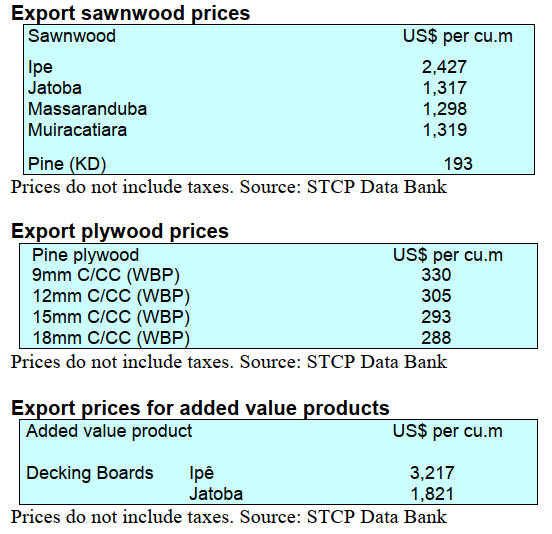
Through the eyes of industry
The latest GTI report lists the challenges identified by the private
sector in Brazil.
See: https://www.itto-
ggsc.org/static/upload/file/20240929/1727586546173092.pdf
9. PERU
ADEX hosts IX
International Forestry Convention
The Association of Exporters (ADEX) held its IX
International Forestry Convention in early October at its
offices in Lima. The event focused on analysing policies
that promote a sustainable forestry industry, sharing
successful forest management experiences and identifying
investment opportunities. Recent policies and regulations
affecting the wood industry were examined and business
opportunities at the market and product level were
addressed.
In addition, networks and collaboration between
government entities, non-governmental entities,
international cooperation agencies and the private sector
were promoted. During a specialised workshop on
requirements for the acceptance of tropical wood under the
United States building code was held.
Sawn tropical hardwood the top export item
ADEX has reported between January and August 2024
Peru's wood product exports reached US$54.7 million, a
drop of 21% compared to the US$69.3 recorded in the
same period of the previous year.
The ADEX report says in the first eight months of this
year the most important item was "other sawn tropical
wood" worth US$11.4 million (-32% year on year).
This was followed by followed by "profiled wood except
ipé" (US$11.1), "other sawn or rough-cut wood" (US$6.3
million), "molded wood of tropical wood" (US$3.8
million) and "other longitudinally profiled wood" (US$2.6
million).
The main destinations were France (US$9.2 mil.), the
United States (US$8.7mil.), Dominican Republic
(US$7.3mil.), China (US$7.2mil.) and Mexico
(US$6.2mil.). Vietnam, Denmark, Belgium, Chile and
Germany completed the top ten export destinations.
Species with potential for promotion in the US
The president of the Committee of Wood and Wood
Industries of ADEX, Erik Fischer Llanos, reported that
they are seeking to promote the export of a greater variety
of Peruvian wood species to the United States targeting the
construction sector.
Fischer Llanos said “This is a new approach. Today there
are buildings with 15 or 18 floors made of wood so this
material has taken on an important new role. The forest
species Aguano Masha, Capirona, Huayruro, Machimango
Colorado, Mashonaste, Palisangre and Pumaquiro have
captured the interest of the US Forest Service, he added.
Fisher mentioned that wood is gaining more and more
followers in the United States and is an alternative
material to cement. Year after year, larger projects appear,
one of them is the Ascent tower in Wisconsin, a 25-story,
86 metre construction that houses apartments, a pool,
shops and other amenities.
During the ADEX Convention representatives of the US
Forest Service-USAID spoke about the requirements for
the entry of wood into the United States building code and
explained the procedures that companies must comply
with.
Fisher Llanos commented that in meetings held with
representatives of the US Forest Service-USAID, they
referred to the advances, challenges and opportunities
generated by the development of the Peruvian national
industry with a view to projecting itself to the North
American market.
Fischer highlighted Peru's progress in terms of forest
governance, with special mention done by the Agency for
the Supervision of Forest Resources and Wildlife
(Osinfor) on the control and administration of resources.
Strengthen the fight against illegal logging
The Permanent Multi-sectoral Commission against Illegal
Logging (CMLTI) and the Amazon Regional Association
(MRA) signed an intergovernmental agreement to
strengthen the fight against illegal logging and associated
trade in the Amazon. The agreement marks a milestone in
the collaboration between national and regional
authorities, as it aligns efforts to strengthen forest
management.
The Agreement promotes a transparent and
sustainable
forest market by providing traceability for wood products
ensuring that they come from legal sources.
See: https://www.gob.pe/institucion/osinfor/noticias/1037818-
comision-multisectorial-y-mancomunidad-regional-amazonica-
firman-un-acuerdo-por-los-bosques-para-fortalecer-la-lucha-
contra-la-tala-ilegal
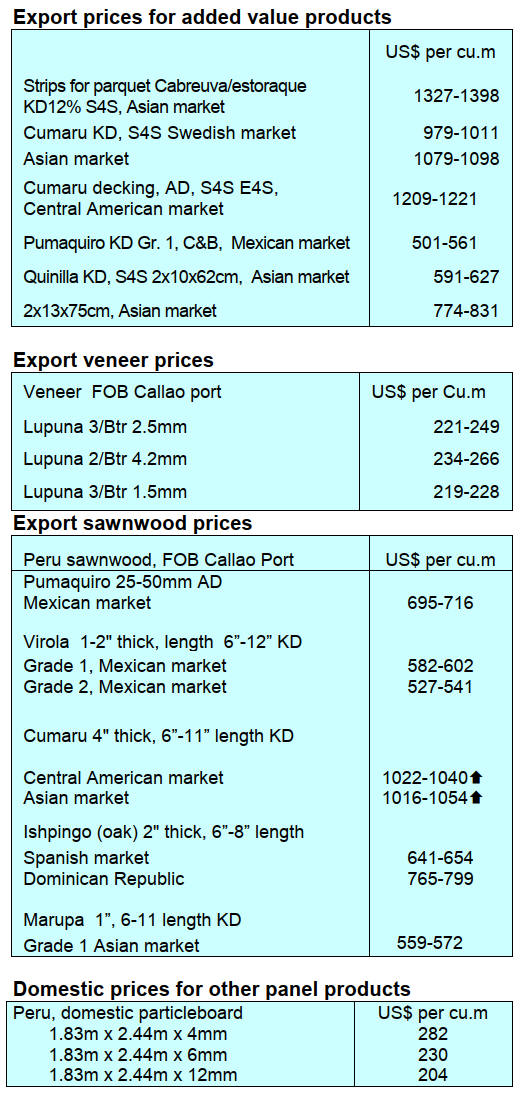 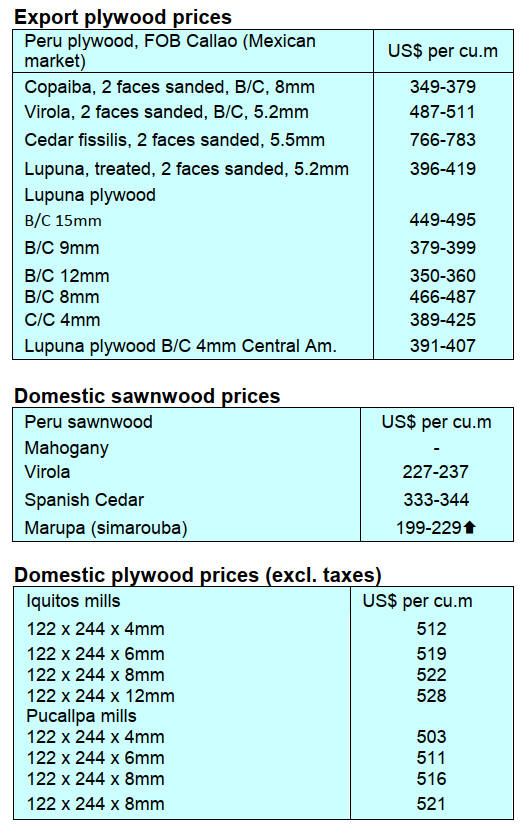
|